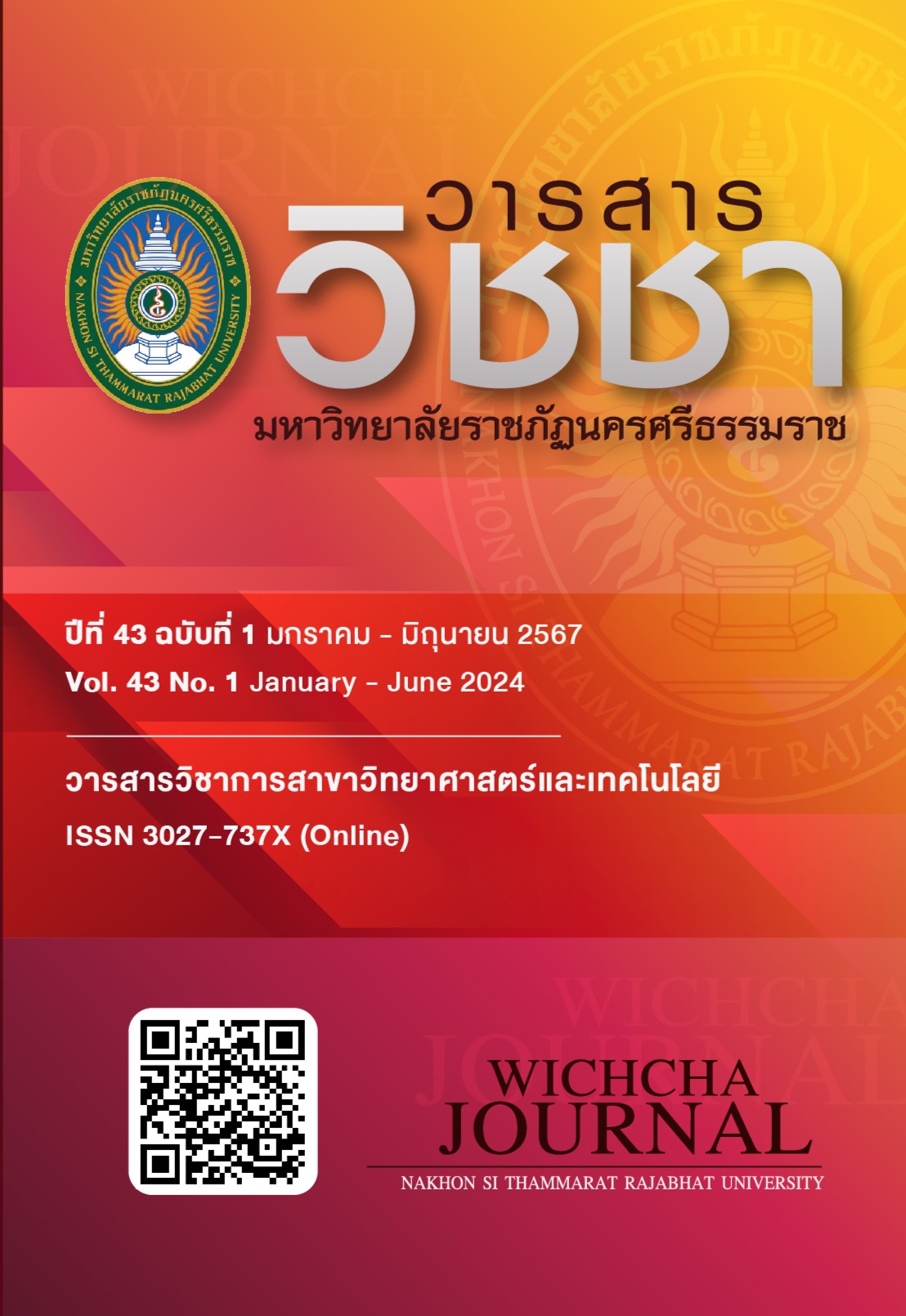การวิเคราะห์ปริมาณโลหะหนักในผลิตภัณฑ์อาหารทะเลตากแห้ง โดยเทคนิคอินดักทีฟลีคัปเปิลพลาสมา-ออพติคอลอิมิสชันสเปกโทรเมตรี
Main Article Content
บทคัดย่อ
งานวิจัยนี้มีวัตถุประสงค์เพื่อเปรียบเทียบการเตรียมตัวอย่างโดยการย่อยแบบเปียก และการย่อยตัวอย่างด้วยระบบไมโครเวฟสำหรับวิเคราะห์ปริมาณแมงกานีส (Mn) ทองแดง (Cu) สังกะสี (Zn) เหล็ก (Fe) และตะกั่ว (Pb) ในตัวอย่างผลิตภัณฑ์อาหารทะเลตากแห้งด้วยเทคนิคอินดักทีฟลี-คัปเปิลพลาสมา-ออพติคอลอิมิสชันสเปกโทรเมตรี (ICP-OES) สุ่มเก็บตัวอย่างจากตลาดในจังหวัดสุราษฎร์ธานี 5 พื้นที่ ได้แก่ อำเภอเมือง (A1) อำเภอกาญจนดิษฐ์ (A2) อำเภอดอนสัก (A3) อำเภอไชยา (A4) และอำเภอท่าฉาง (A5) ในเดือนพฤษภาคม พ.ศ. 2565 ผลการศึกษาพบว่าการย่อยด้วยระบบไมโครเวฟเป็นวิธีที่เหมาะสมสำหรับขั้นตอนการเตรียมตัวอย่าง และการศึกษาความใช้ได้ของวิธีวิเคราะห์พบว่าค่าสัมประสิทธิ์สหสัมพันธ์ของกราฟมาตรฐานมีค่าอยู่ในช่วง 0.9990-0.9998 ความถูกต้องและความเที่ยงมีค่าอยู่ในช่วงร้อยละ 84.9-111.8 และ 1.7-7.4 ตามลำดับ ความเข้มข้นต่ำสุดของการตรวจวัด (LOD) เท่ากับ 5.1 11.1 17.3 13.5 และ 14.5 นาโนกรัมต่อกรัม และความเข้มข้นต่ำสุดของปริมาณที่วิเคราะห์ได้ (LOQ) เท่ากับ 5.6 12.9 26.2 14.5 และ 15.0 นาโนกรัมต่อกรัม สำหรับโลหะหนัก ได้แก่ แมงกานีส ทองแดง สังกะสี เหล็ก และตะกั่ว ตามลำดับ ผลการวิเคราะห์โลหะหนักพบว่าปริมาณเฉลี่ยของโลหะหนักในตัวอย่างอาหารทะเลตากแห้งทั้งหมดเรียงลำดับจากมากไปน้อยเป็นดังนี้ เหล็ก สังกะสี ทองแดง แมงกานีส ซึ่งมีค่าเท่ากับ 49.53±33.31 15.33±11.86 4.15±5.90 และ 2.88±1.92 มิลลิกรัมต่อกิโลกรัมของน้ำหนักสด ตามลำดับ สำหรับปริมาณตะกั่วในตัวอย่างทั้งหมดไม่สามารถตรวจวิเคราะห์ปริมาณได้ นอกจากนี้พบว่าปริมาณเหล็กและทองแดงในตัวอย่างกุ้งแห้งและหมึกกล้วยดำมีค่าร้อยละของปริมาณที่แนะนำต่อวันอยู่ในระดับดีเยี่ยม (ร้อยละ 27.6-93.1)
Article Details

อนุญาตภายใต้เงื่อนไข Creative Commons Attribution-NonCommercial-NoDerivatives 4.0 International License.
เนื้อหาและข้อมูลในบทความที่ลงตีพิมพ์ในวารสารวิชชา มหาวิทยาลัยราชภัฏนครศรีธรรมราช ถือเป็นข้อคิดเห็นและความรับผิดชอบของผู้เขียนบทความโดยตรง ซึ่งกองบรรณาธิการวารสารไม่จำเป็นต้องเห็นด้วยหรือร่วมรับผิดชอบใด ๆ
บทความ ข้อมูล เนื้อหา รูปภาพ ฯลฯ ที่ได้รับการตีพิมพ์ในวารสารวิชชา มหาวิทยาลัยราชภัฏนครศรีธรรมราช ถือเป็นลิขสิทธ์ของวารสารวิชชา มหาวิทยาลัยราชภัฏนครศรีธรรมราช หากบุคคลหรือหน่วยงานใดต้องการนำข้อมูลทั้งหมดหรือส่วนหนึ่งส่วนใดไปเผยแพร่ต่อหรือเพื่อการกระทำการใด ๆ จะต้องได้รับอนุญาตเป็นลายลักษณ์อักษรจากวารสารวิชชา มหาวิทยาลัยราชภัฏนครศรีธรรมราชก่อนเท่านั้น
The content and information in the article published in Wichcha journal Nakhon Si Thammarat Rajabhat University, It is the opinion and responsibility of the author of the article. The editorial journals do not need to agree. Or share any responsibility.
เอกสารอ้างอิง
รัชดา อิทธิพงษ์ และวลัย คลี่ฉายา. (2557). การปนเปื้อนโลหะหนักในสัตว์น้ำจากสะพานปลาท่าเทียบเรือ. เอกสารวิชาการฉบับที่ 3/2557. กองพัฒนาอุตสาหกรรมสัตว์น้ำ, กรมประมง.
แววตา ทองระอา ฉลวย มุสิกะ วันชัย วงสุดาวรรณ และอาวุธ หมั่นหาผล. (2557). การประเมินความเสี่ยงต่อสุขภาพในการได้รับโลหะหนักจากการบริโภคอาหารทะเลบริเวณชายฝั่งนิคมอุตสาหกรรมมาบตาพุด จังหวัดระยอง. วารสารวิทยาศาสตร์บูรพา, 19(2), 39-54.
สมชาย วิบุญพันธ์ ธิดารัตน์ คงชัย อุทิศ โชติธรรมโม และพิมพ์วิมล อินทร์แก้ว. (2558). ศึกษาปริมาณโลหะหนักในสัตว์น้ำและแหล่งประมงบริเวณชายฝั่งจังหวัดสงขลา ปี 2554. เอกสารวิชาการฉบับที่ 4/2558. กองวิจัยและพัฒนาประมงทะเล, กรมประมง.
สุดชฎา ศรประสิทธิ์ กิ่งแก้ว กาญจนรัตน์ และอรัญญา อัศวอารีย์. (2560). การประเมินความเสี่ยงโลหะหนักในปลาและกุ้งจากทะเลสาบสงขลาต่อคนไทย. วารสารกรมวิทยาศาสตร์การแพทย์, 59(2), 115-127.
Arthur, W., Asiamah, E., Dowuona, J., Crabbe, G. and Kortei, N.K. (2021). Concentration of heavy metals and its risk assessments on Pseudotolithus senegalensis, Sciaenops ocellatus and Chloroscombrus chrysurus smoked on different ovens. Scientific African, 13, doi: https://doi.org/10.1016/j.sciaf.2021.e00953.
Banna, H.A., Zaber, A.A., Rahman, N., Siddique, A.M., Siddique, M.A.B., Hagan, J.E., Rifat, M.A., Nasiah-Asamoah, C.N.A., Seidu, A., Ahinkorah, B.O. and Khan, M.S.I. (2022). Nutritional value of dry fish in Bangladesh and its potential contribution to addressing malnutrition: A narrative review. Fishes, 7(5), doi: https://doi.org/10.3390/fishes7050240.
Cai, S.W., Ni, Z.H., Liu, B. and Fan, L.L. (2017). Metal concentrations and health risk assessment in the muscle of ten commercial fish species from the Chishui river, China. International Journal of Environmental Research, 11, 125-132, doi: http://doi.org/10.1007/s41742-017-0013-7.
Copat, C., Arena, G., Fiore, M., Ledda, C., Fallico, R., Sciacca, S. and Ferrante, M. (2013). Heavy metal concentrations in fish and shellfish from eastern Mediterranean Sea: Consumption advisories. Food and Chemical Toxicology, 53, 33-37, doi: https://doi.org/10.1016/j.fct.2012.11.038.
Hoque, S., Tamanna, F., Hasan, M., Banna, H.A., Mondal, P., Prodhan, M.D.H., Rahman, Z. and Brakel, M.L. (2022). Probabilistic public health risk associated with pesticides and heavy metal exposure through consumption of common dried fish in coastal regions of Bangladesh. Environmental Science and Pollution Research, 29(14), 20112-20127, doi: https://doi.org/10.1007/s11356-021-17127-9.
Jiao, Y., Chen, J., Li, W., Liu, Y., Xin, C. and Yang, L. (2018). Trace element concentrations in squids consumed in Shandong province, China and their associated risks to the human health. Marine Pollution Bulletin, 128, 267-274, doi: https://doi.org/10.1016/j.marpolbul.2018.01.038.
Kar, M., Hoq, E., Islam, S., Islam, M., Meghla, N.T., Suravi, S. and Kabir, H. (2020). Monitoring of proximate composition, heavy metal concentrations and pesticide residues in marine dried fish available in the coastal region of Bangladesh. Grassroots Journal of Natural Resources, 3(2), 30-41, doi: https://doi.org/10.33002/nr2581.6853.03023.
Makedonski, L., Peycheva, K. and Stancheva, M. (2017). Determination of heavy metals in selected black sea fish species. Food Control, 72, 313-318, doi: https://doi.org/10.1016/j.foodcont.2015.08.024.
Panebianco, F., Nava, V., Giaratana, F., Gervasi, T. and Cicero, N. (2021). Assessment of heavy- and semi-metals contamination in edible seaweed and dried fish sold in ethnic food stores on the Italian market. Journal of Food Composition and Analysis, 104(9), doi: https://doi.org/10.1016/j.jfca.2021.104150.
Pinto, F.R., Duarte, A.M., Silva, F., Barroso, S., Mendes, S., Pinto, E., Almeida, A., Sequeira, V., Vieira, A.R., Gordo, L.S. and Gil, M.M (2022). Annual variations in the mineral element content of five fish species from the Portuguese coast. Food Research International, 158, doi: https://doi.org/10.1016/j.foodres.2022.111482.
Police, S., Maity, S., Chaudhary, D.K., Dusane, C.K., Sahu, S.K. and Kumar, A.V. (2021). Estimation of trace and toxic metals in marine biota and associated health risk assessment in Thane Creek, Mumbai, India. Environmental Chemistry and Ecotoxicology, 3(1), 234-240, doi: https://doi.org/10.1016/j.enceco.2021.07.002.
Rakib, R.J., Jolly, Y.N., Enyoh, C.E., Khandaker, M.U., Hossain, M.B., Akther, S., Alsubaie, A., Almalki, A.S.A. and Bradley, D.A. (2021). Levels and health risk assessment of heavy metals in dried fish consumed in Bangladesh. Scientific Reports, 11(1), doi: https://doi.org/10.1038/s41598-021-93989-w.
Tanhan, P., Lansubsakul, N., Phaochoosak, N., Sirinupong, P., Yeesin, P. and Imsilp, K. (2023). Human health risk assessment of heavy metal concentration in seafood collected from Pattani Bay, Thailand. Toxics, 11(1), doi: https://doi.org/10.3390/toxics11010018.
US FDA. (2018). Food labeling: serving sizes of foods that can reasonably be consumed at one eating occasion; dual-column labeling; updating, modifying, and establishing certain reference amounts customarily consumed; serving size for breath mints; and technical amendments. Retrieved 1 December 2022, from: https://www.fda.gov/media/111144/download.
US FDA. (2022). Daily value on the new nutrition and supplement facts labels. Retrieved 1 December 2022, from: https://www.fda.gov/food/new-nutrition-facts-label/daily-value-new-nutrition-and-supplement-facts-labels.
Vu, C.T., Lin, C., Yeh, G. and Villanueva, M.C. (2017). Bioaccumulation and potential sources of heavy metal contamination in fish species in Taiwan: assessment and possible human health implications. Environmental Science and Pollution Research, 24, 19422-19434, doi: https://doi.org/10.1007/s11356-017-9590-4.
Yu, B., Wang, X., Dong, K.F., Xiao, G. and Ma, D. (2020). Heavy metal concentrations in aquatic organisms (fishes, shrimp and crabs) and health risk assessment in China. Marine Pollution Bulletin, 159, doi: https://doi.org/10.1016/j.marpolbul.2020.111505.


